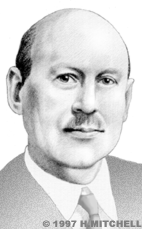Robert Goddard
Robert Hutchings Goddard was an inventor and visionary who, more than anyone else, paved the way for the Space Age.
The son of a Boston machine shop owner, Goddard earned a BS from Worcester Polytechnic Institute in Mass. (1908) and a PhD in Physics from nearby Clark University (1911), where he worked and taught for most of his life (1914-1945).
By 1914, Goddard had earned 2 of his eventual total of 214 patents, for the first liquid-fueled rocket and the first multi-stage rocket. Soon thereafter, he developed the fundamental mathematics of rocket propulsion and proposed that it might be possible one day to send a rocket to the moon (1920). Goddard supported his theories with a series of experiments, including the launch of the first liquid-fueled rocket (March 1926) and the first rocket to carry a scientific payload – a barometer and camera (July 1929).
These launches are now considered as monumental as the Wright brothers' flight of December 1903. But then, Goddard's futuristic predictions made him seem a near lunatic to many, and because of his literally earthshaking launches, he was banned from further experiments in Massachusetts. Goddard was rescued by Charles Lindbergh, who helped him win a grant from philanthropist Daniel Guggenheim.
Goddard set up an experimental station in Roswell, New Mexico, where, throughout the 1930s, he created the bases of modern rocketry, including gyroscopic directional controls, exhaust-deflection steering, rapid-combustion fuels, and power-driven fuel pumps. In World War II, Goddard worked for the Navy. Ironically, the Germans took his work more seriously, and thus benefitted more from it, than did his own compatriots.
Robert Goddard died of cancer just as the war was ending and never saw the long-term results of his work. In 1959, however, Congress dedicated NASA's Goddard Space Flight Center to him. His work lives on in the fundamentals of the industry that he made possible.


